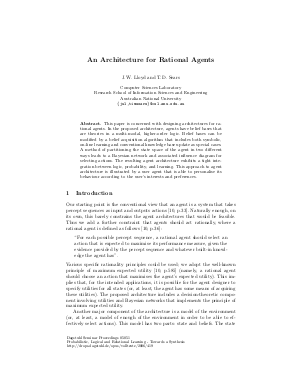An Architecture for Rational Agents
Authors John W. Lloyd, Tim D. Sears
-
Part of:
Volume:
Dagstuhl Seminar Proceedings, Volume 5051
Part of: Series: Dagstuhl Seminar Proceedings (DagSemProc) - License:
 Creative Commons Attribution 4.0 International license
Creative Commons Attribution 4.0 International license
- Publication Date: 2006-01-19
File

PDF
DagSemProc.05051.3.pdf
- Filesize: 249 kB
- 16 pages
Document Identifiers
Subject Classification
Keywords
- Rational agent
- agent architecture
- belief base
- Bayesian networks
Metrics
- Access Statistics
-
Total Accesses (updated on a weekly basis)
0PDF Downloads0Metadata Views
Abstract
This paper is concerned with designing architectures for rational agents. In the proposed architecture, agents have belief bases that are theories in a multi-modal, higher-order logic. Belief bases can be modified by a belief acquisition algorithm that includes both symbolic, on-line learning and conventional knowledge base update as special cases. A method of partitioning the state space of the agent in two different ways leads to a Bayesian network and associated influence diagram for selecting actions. The resulting agent architecture exhibits a tight integration between logic, probability, and learning. This approach to agent architecture is illustrated by a user agent that is able to personalise its behaviour according to the user's interests and preferences.
Cite As Get BibTex
John W. Lloyd and Tim D. Sears. An Architecture for Rational Agents. In Probabilistic, Logical and Relational Learning - Towards a Synthesis. Dagstuhl Seminar Proceedings, Volume 5051, pp. 1-16, Schloss Dagstuhl – Leibniz-Zentrum für Informatik (2006)
https://doi.org/10.4230/DagSemProc.05051.3
BibTex
@InProceedings{lloyd_et_al:DagSemProc.05051.3,
author = {Lloyd, John W. and Sears, Tim D.},
title = {{An Architecture for Rational Agents}},
booktitle = {Probabilistic, Logical and Relational Learning - Towards a Synthesis},
pages = {1--16},
series = {Dagstuhl Seminar Proceedings (DagSemProc)},
ISSN = {1862-4405},
year = {2006},
volume = {5051},
editor = {Luc De Raedt and Thomas Dietterich and Lise Getoor and Stephen H. Muggleton},
publisher = {Schloss Dagstuhl -- Leibniz-Zentrum f{\"u}r Informatik},
address = {Dagstuhl, Germany},
URL = {https://drops.dagstuhl.de/entities/document/10.4230/DagSemProc.05051.3},
URN = {urn:nbn:de:0030-drops-4192},
doi = {10.4230/DagSemProc.05051.3},
annote = {Keywords: Rational agent, agent architecture, belief base, Bayesian networks}
}
